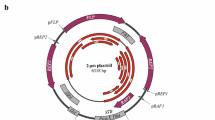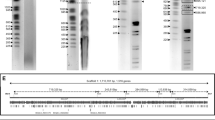Summary
Some derivatives of pIJ101, a 8.9 kb Streptomyces multi-copy plasmid, can co-exist with each other at similar copy numbers but others are strongly incompatible. The DNA sequence, sti, which causes this “strong incompatibility” was localised on a DNA segment of about 200 bp which is not part of the essential replication region of pIJ101. The sti function is active only when the DNA fragment carrying it is present in the natural orientation with respect to the basic replication region of pIJ101. Pairs of plasmids which either both possess sti in the correct orientation (Sti+) or both lack sti or carry it in reverse orientation (Sti-) can co-exist, but Sti+ and Sti- plasmids cannot; in this case the Sti+ plasmid is retained and the Sti- plasmid is lost. This phenomenon is called strong incompatibility to distinguish it from classical incompatibility where identical or related plamids are incompatible and dissimilar plasmids are compatible. pIJ101 probably replicates via a single-stranded intermediate; sti would be a site where the synthesis of the second (lagging) DNA strand is initiated because Sti- plasmids accumulate more single-stranded plasmid DNA than Sti+ plasmids. The copy number of pIJ101 and its derivatives is influenced by sti and by an additional trans-acting function (cop).
Similar content being viewed by others
References
Ambartsumyan NS, Mazo AM (1980) Elimination of the secondary structure effect in gel sequencing of nucleic acids. FEBS Lett 14:265–268
Bailey CR, Bruton CJ, Butler MJ, Chater KF, Harris JE, Hopwood DA (1986) Properties of in vitro recombinant derivatives of pJV1, a multi-copy plasmid from Streptomyces phaeochromogenes. J Gen Microbiol 132:2071–2078
Brosius J (1984) Plasmid vectors for the selection of promoters. Gene 27:151–160
Chang S, Chang S-Y, Gray O (1987) Structural and genetic analyses of a par locus that regulates plasmid partition in Bacillus subtilis. J Bacteriol 169:3952–3962
Davison J (1984) Mechanism of control of DNA replication and incompatibility in ColEl-type plasmids—a review. Gene 28:1–15
del Solar GH, Puyet A, Espinosa M (1987) Initiation signals for the conversion of single stranded to double stranded DNA forms in the streptococcal plasmid pLS1. Nucleic Acids Res 15:5561–5580
Deng Z (1987) A molecular study of a region of the Streptomyces plasmid, pIJ101. Ph.D. Thesis, University of East Anglia, Norwich, UK
Dente L, Cesareni G, Cortese R (1983) pEMBL: a new family of single stranded plasmids. Nucleic Acids Res 11:1645–1655
Doull JL, Vining LC, Stuttard C (1983) A cryptic plasmid in the chloramphenicol-producing actinomycete, Streptomyces phaeochromogenes. FEMS Microbiol Lett 16:349–352
Gennaro ML, Novick RP (1986) cmp, a cis-acting plasmid locus that increases interaction between replication origin and initiator protein. J Bacteriol 168:160–166
Gros MF, te Riele H, Ehrlich SD (1987) Rolling circle replication of single-stranded DNA plasmid pC194. EMBO J 6:3863–3869
Gruss AD, Ross HF, Novick RP (1987) Functional analysis of a palindromic sequence required for normal replication of several staphylococcal plasmids. Proc Natl Acad Sci USA 84:2165–2169
Henikoff S (1984) Unidirectional digestion with exonuclease III creates targeted breakpoints of DNA sequencing. Gene 28:351–359
Hopwood DA, Kieser T, Wright HM, Bibb MJ (1983) Plasmids, recombinantion and chromosome mapping in Streptomyces lividans 66. J Gen Microbiol 129:2257–2269
Hopwood DA, Bibb MJ, Chater KF, Kieser T, Bruton CJ, Kieser HM, Lydiate DJ, Smith CP, Ward JM, Schrempf H (1985) Genetic manipulation of Streptomyces: a laboratory manual. The John Innes Foundation, Norwich, UK
Hopwood DA, Bibb MJ, Chater KF, Kieser T (1987) Plasmid and phage vectors for gene cloning and analysis in Streptomyces. Methods Enzymol 153:116–166
Iordanescu S (1986) Effect of the deletion of a fragment dispensable for the autonomous maintenance of plasmid pT181 on the competition between incompatible plasmids. Plasmid 15:191–198
Katz E, Thompson CJ, Hopwood DA (1983) Cloning and expression of the tyrosinase gene from Streptomyces antibioticus in Streptomyces lividans. J Gen Microbiol 129:2703–2714
Kendall KJ, Cohen SN (1987) Plasmid transfer in Streptomyces lividans: identification of a kil-kor system associated with the transfer region of pIJ101. J Bacteriol 169:4177–4183
Kieser T (1984a) Factors affecting the isolation of CCC DNA from Streptomyces lividans and Escherichia coli. Plasmid 12:19–36
Kieser T (1984b) DNAGEL: a computer program for determining DNA fragment sizes using a small computer equipped with a graphics tablet. Nucleic acids Res 12:679–688
Kieser T, Melton RE (1988) Plasmid pIJ699, a multi-copy positiveselection vector for Streptomyces. Gene 65:83–91
Kieser T, Hopwood DA, Wright HM, Thompson CJ (1982) pIJ101, a multi-copy broad host-range Streptomyces plasmid: functional analysis and development of DNA cloning vectors. Mol Gen Gent 185:223–238
Marians KJ, Soeller W, Zipursky SL (1982) Maximial limits of the Escherichia coli replication factor Y effector sites sequences in pBR322 DNA. J Biol Chem 257:5656–5662
Maxam AM, Gilbert W (1980) Sequencing end-labelled DNA with base specific chemical cleavages. Methods Enzymol 65:499–560
Murray NE, Brammar WJ, Murray K (1977) Lambdoid phages that simplify the recovery of in vitro recombinants. Mol Gen Genet 150:53–61
Novick RP (1987) Plasmid incompatibility. Microbiol Rev 51:381–395
Novick RP, Clowes RC, Cohen SN, Curtiss R, Datta N, Falkow S (1976) Uniform nomenclature for bacterial plasmids: a proposal. Bacteriol Rev 40:168–189
Ranki M, Palva A, Virtanen M, Laaksonen M, Söderlund H (1983) Sandwich hybridization as a convenient method for the detection of nucleic acids in crude samples. Gene 21:77–85
Schrempf H, Pigac J (1986) Single stranded plasmid DNA in Streptomyces. Abstract Fifth International Symposium on the Genetics of Industrial Microorganisms. Split, Yugoslavia
Stuitje AR, Weisbeek PJ, Meier M (1984) Initiation signals for complementary strand DNA synthesis in the region of the replication origin of the Escherichia coli chromosome. Nucleic Acids Res 12:3321–3332
te Riele H, Michel B, Ehrlich SD (1986a) Single-stranded plasmid DNA in Bacillus subtilis and Staphylococcus aureus. Proc Natl Acad Sci USA 83:2541–2545
te Riele H, Michel B, Ehrlich SD (1986b) Are single-stranded circles intermediates in plasmid DNA replication? EMBO J 5:631–637
Thomas CM, Meyer R, Helinski DR (1980) Regions of broad-hostrange plasmid RK2 which are essential for replication and maintenance. J Bacteriol 141:213–222
Tucker WT, Miller CA, Cohen SN (1984) Structural and functional analysis of the par region of the pSC101 plasmid. Cell 38:191–201
Ward J, Janssen GR, Kieser T, Bibb MJ, Buttner MJ, Bibb MJ (1986) Construction and characterisation of a series of multicopy promoter-probe plasmid vectors for Streptomyces using the aminoglycoside phosphotransferase gene from Tn5 as indicator. Mol Gen Genet 203:468–478
Yanisch-Perron C, Vieira J, Messing J (1985) Improved M13 phage cloning vectors and host strains: nucleotide sequences of the M13mp18 and pUC19 vectors. Gene 33:103–119
Author information
Authors and Affiliations
Additional information
Communicated by N.D.F. Grindley
Rights and permissions
About this article
Cite this article
Deng, Z., Kieser, T. & Hopwood, D.A. “Strong incompatibility” between derivatives of the Streptomyces multi-copy plasmid pIJ101. Mol Gen Genet 214, 286–294 (1988). https://doi.org/10.1007/BF00337723
Received:
Issue Date:
DOI: https://doi.org/10.1007/BF00337723




